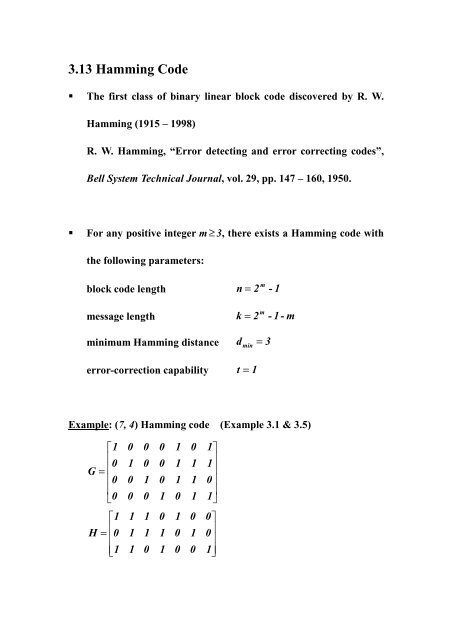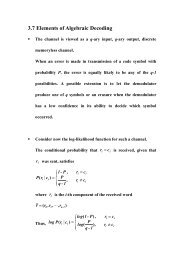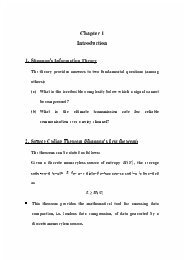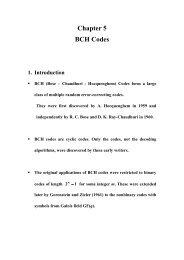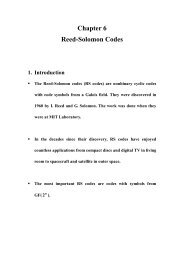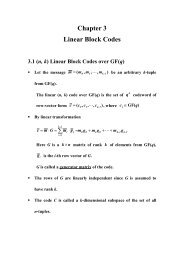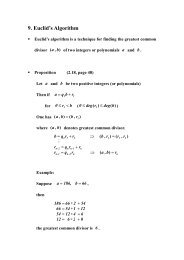3.13 Hamming Code
You also want an ePaper? Increase the reach of your titles
YUMPU automatically turns print PDFs into web optimized ePapers that Google loves.
<strong>3.13</strong> <strong>Hamming</strong> <strong>Code</strong><br />
The first class of binary linear block code discovered by R. W.<br />
<strong>Hamming</strong> (1915 – 1998)<br />
R. W. <strong>Hamming</strong>, “Error detecting and error correcting codes”,<br />
Bell System Technical Journal, vol. 29, pp. 147 – 160, 1950.<br />
<br />
For any positive integer m ≥ 3, there exists a <strong>Hamming</strong> code with<br />
the following parameters:<br />
block code length<br />
m<br />
n = 2 - 1<br />
message length<br />
k = 2<br />
m<br />
- 1 -<br />
m<br />
minimum <strong>Hamming</strong> distance d min<br />
= 3<br />
error-correction capability t = 1<br />
Example:(7, 4) <strong>Hamming</strong> code (Example 3.1 & 3.5)<br />
G<br />
⎡1<br />
⎢<br />
0<br />
= ⎢<br />
⎢0<br />
⎢<br />
⎣0<br />
0<br />
1<br />
0<br />
0<br />
0<br />
0<br />
1<br />
0<br />
0<br />
0<br />
0<br />
1<br />
1<br />
1<br />
1<br />
0<br />
0<br />
1<br />
1<br />
1<br />
1⎤<br />
1<br />
⎥<br />
⎥<br />
0⎥<br />
⎥<br />
1⎦<br />
⎡1<br />
H =<br />
⎢<br />
0<br />
⎢<br />
⎢⎣<br />
1<br />
1<br />
1<br />
1<br />
1<br />
1<br />
0<br />
0<br />
1<br />
1<br />
1<br />
0<br />
0<br />
0<br />
1<br />
0<br />
0⎤<br />
0<br />
⎥<br />
⎥<br />
1⎥⎦
For a <strong>Hamming</strong> code of length 2 m - 1 , its parity-check matrix is<br />
a matrix whose columns consist of the entire set of the non-zero<br />
binary m-tuples.<br />
3.14 Golay <strong>Code</strong><br />
<br />
The (23,12) Gloay code is the only known multiple-errorcorrecting<br />
binary perfect code, which is capable of correcting 3<br />
or fewer random errors in a block of 23 digits, d min<br />
= 7 .<br />
(Discovered by Golay in 1949).<br />
<br />
The (23, 12) Gloay code is either generated by<br />
g +<br />
2 4 5 6 10 11<br />
1(<br />
x)<br />
= 1 + x + x + x + x + x x<br />
or by<br />
g +<br />
5 6 7 9 11<br />
2<br />
( x)<br />
= 1 + x + x + x + x + x x<br />
Both g 1<br />
(x)<br />
and g 2<br />
(x)<br />
are factors of x 23 + 1<br />
23<br />
and + 1 = ( 1 + x)<br />
g ( x)<br />
g ( x)<br />
x<br />
1 2
Golay’s paper was published in 1949.<br />
M. J. E. Golay, “Notes on digital coding”, proc. IRE, 37, pp. 567,<br />
June 1949.<br />
<br />
Golay codes have been frequent application in the US space<br />
program, most notably with the Voyager I and II spacecraft,<br />
providing (1979 – 81) clear color pictures of Jupiter and Saturn.<br />
3.15 Reed-Muller <strong>Code</strong> (RM <strong>Code</strong>)<br />
<br />
Reed-Muller codes were discovered by Muller in 1954, and<br />
shortly thereafter a better algebraic representation was provided<br />
by Reed along with an elegant decoding algorithm.<br />
<br />
The first-order RM code of length 32 wasusedin1969forthe<br />
error-control system of the Mariner and Viking deep-space<br />
probes of Mars.
The original r-th order RM codes were binary and noncyclic, and<br />
formed a special subclass of Euclidean geometry (EG) codes.<br />
(Details can also be found in Lin / Costello Book, chap. 8)<br />
The r-th order binary RM code has the following parameters:<br />
m<br />
n = 2<br />
k<br />
⎛m⎞<br />
⎛m⎞<br />
⎛m⎞<br />
= 1 + ⎜ ⎟ + ⎜ ⎟ + L+<br />
⎜ ⎟<br />
⎝ 1 ⎠ ⎝ 2 ⎠ ⎝ r ⎠<br />
n - k<br />
= 2<br />
m<br />
- k<br />
=<br />
m<br />
∑ − r − 1<br />
i=<br />
0<br />
⎛<br />
⎜<br />
⎝<br />
m<br />
i<br />
⎞<br />
⎟<br />
⎠<br />
m-r<br />
d<br />
min<br />
= 2<br />
Where r
Let v0<br />
be a vector whose<br />
m<br />
2 components are all 1s. Then v 0<br />
is called an identity vector.<br />
Let<br />
v L be the rows of a matrix with all possible<br />
1<br />
,v2<br />
, , vm<br />
m-tuples as columns. We call them the basis vectors.<br />
The r-th order RM code is formed by using the basis vectors<br />
v L and all of their vector products r or fewer at a time.<br />
1<br />
,v2<br />
, , vm<br />
<br />
The generator matrix of the r-th order RM code is defined as<br />
⎡ v0<br />
⎢<br />
v<br />
⎢<br />
1<br />
⎢ M<br />
⎢<br />
⎢<br />
vm<br />
⎢ v1v2<br />
⎢<br />
⎢ v1v3<br />
⎢ M<br />
⎢<br />
G = ⎢ vm-1vm<br />
⎢ v1v2v3<br />
⎢<br />
⎢ M<br />
⎢ vm-2vm-1vm<br />
⎢<br />
⎢ M<br />
⎢<br />
v<br />
⎢<br />
1v2<br />
Lvr<br />
⎢ M<br />
⎢<br />
⎣vm-r<br />
1Lv<br />
v<br />
⎤<br />
⎥<br />
⎥<br />
⎥<br />
⎥<br />
⎥<br />
⎥<br />
⎥<br />
⎥<br />
⎥<br />
⎥<br />
⎥<br />
⎥<br />
⎥<br />
⎥<br />
⎥<br />
⎥<br />
⎥<br />
⎥<br />
⎥<br />
⎥<br />
⎥<br />
⎦<br />
or<br />
⎡<br />
⎢<br />
⎢<br />
⎢<br />
⎢<br />
⎢<br />
⎢<br />
⎢<br />
⎢<br />
⎢<br />
⎢<br />
⎢<br />
⎢<br />
⎢<br />
⎢<br />
⎢<br />
⎢<br />
⎢<br />
⎢<br />
⎢<br />
⎢<br />
⎢<br />
⎣v<br />
m-1<br />
m-2<br />
+ m-1 m<br />
m m-1 m-r+<br />
1<br />
where v = v ,v , L,<br />
v )<br />
i<br />
(<br />
i,0 i,1 i,n-1<br />
v<br />
v<br />
m<br />
v<br />
v<br />
v<br />
v<br />
m<br />
m<br />
v<br />
v<br />
v<br />
m-1<br />
v<br />
v<br />
v<br />
2<br />
0<br />
m<br />
M<br />
M<br />
1<br />
m-1<br />
m-2<br />
v<br />
M<br />
M<br />
1<br />
v<br />
Lv<br />
⎤<br />
⎥<br />
⎥<br />
⎥<br />
⎥<br />
⎥<br />
⎥<br />
⎥<br />
⎥<br />
⎥<br />
⎥<br />
⎥<br />
⎥<br />
⎥<br />
⎥<br />
⎥<br />
⎥<br />
⎥<br />
⎥<br />
⎥<br />
⎥<br />
⎥<br />
⎦
Example:<br />
Consider the 2 nd -order RM code for m=4,<br />
n = 2<br />
4 =<br />
16<br />
⎛4⎞<br />
⎛4⎞<br />
k = 1 + ⎜ ⎟ + ⎜ ⎟ = 11<br />
⎝ 1⎠<br />
⎝ 2⎠<br />
n - k = 16 - 11 = 5<br />
d<br />
= 2<br />
2<br />
min<br />
=<br />
4<br />
This is a (16, 11) linear code.<br />
The generator matrix is given by<br />
G<br />
R(<br />
2, 4)<br />
⎡ v0<br />
⎢<br />
v<br />
⎢<br />
4<br />
⎢ v3<br />
⎢<br />
⎢<br />
v2<br />
⎢ v1<br />
⎢<br />
= ⎢v4v<br />
⎢v4v<br />
⎢<br />
⎢v4v<br />
⎢v3v<br />
⎢<br />
⎢v3v<br />
⎢<br />
⎣v2v<br />
3<br />
2<br />
1<br />
2<br />
1<br />
1<br />
⎤<br />
⎥<br />
⎥<br />
⎥<br />
⎥<br />
⎥<br />
⎥<br />
⎥<br />
⎥<br />
⎥<br />
⎥<br />
⎥<br />
⎥<br />
⎥<br />
⎥<br />
⎥<br />
⎦
where<br />
v 0<br />
= ( 1 1 1 1 1 1 1 1 1 1 1 1 1 1 1 1 )<br />
v 4<br />
= ( 0 0 0 0 0 0 0 0 1 1 1 1 1 1 1 1 )<br />
v 3<br />
= ( 0 0 0 0 1 1 1 1 0 0 0 0 1 1 1 1 )<br />
v 2<br />
= ( 0 0 1 1 0 0 1 1 0 0 1 1 0 0 1 1 )<br />
v 1<br />
= ( 0 10 1 0 10 1 0 10 1 0 10 1 )<br />
v 4<br />
v 3<br />
= ( 0 0 0 0 0 0 0 0 0 0 0 0 1 1 1 1 )<br />
v 4<br />
v 2<br />
= ( 0 0 0 0 0 0 0 0 0 0 1 1 0 0 1 1 )<br />
v 4<br />
v 1<br />
= ( 0 0 0 0 0 0 0 0 0 10 1 0 10 1 )<br />
v 3<br />
v 2<br />
= ( 0 0 0 0 0 0 1 1 0 0 0 0 0 0 1 1 )<br />
v 3<br />
v 1<br />
= ( 0 0 0 0 0 10 1 0 0 0 0 0 10 1 )<br />
v 2<br />
v 1<br />
= ( 0 0 0 1 0 0 0 1 0 0 0 1 0 0 0 1 )<br />
⎛ m⎞<br />
⎛m⎞<br />
⎛m⎞<br />
⎛ m⎞<br />
Since k = ⎜ ⎟ + ⎜ ⎟ + ⎜ ⎟ + L+<br />
⎜ ⎟<br />
⎝ 0 ⎠ ⎝ 1 ⎠ ⎝ 2 ⎠ ⎝ r ⎠<br />
gives the number of information bits of the r-th order RM code of<br />
length<br />
m<br />
2 , the information vector is generally expressed as<br />
d<br />
0 m m-1 1 m,m-1 m,m-2<br />
dm,m-1,<br />
,m-r+<br />
= ( d d d<br />
L<br />
Ld<br />
d d L<br />
1)<br />
For example, r=2, m=4, k=11<br />
We have d = d d d d d d d d d d )<br />
(<br />
0 4 3 2 1 43 42 41 32 31<br />
d21
The codewords are given by<br />
c<br />
= d ⋅G<br />
Example: r=1, m=3<br />
c = ( c c1<br />
Lc7<br />
) = ( d0<br />
d3<br />
d2<br />
d1<br />
0<br />
)<br />
⎡1<br />
⎢<br />
0<br />
⎢<br />
⎢0<br />
⎢<br />
⎣0<br />
1<br />
0<br />
0<br />
1<br />
1<br />
0<br />
1<br />
0<br />
1<br />
0<br />
1<br />
1<br />
1<br />
1<br />
0<br />
0<br />
1<br />
1<br />
0<br />
1<br />
1⎤<br />
1<br />
⎥<br />
⎥<br />
1⎥<br />
⎥<br />
0⎦


